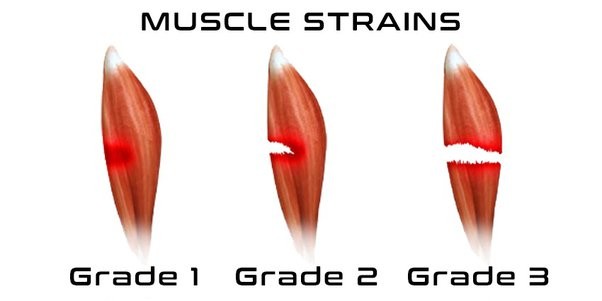
Contents
- 1 How Long Does It Take for a Muscle Strain to Heal?
- 1.0.1 Signs and symptoms of muscle strain
- 1.0.2 Types of muscle strain
- 1.0.3 Causes of muscle strain
- 1.0.4 When to see the doctor for muscle strain
- 1.0.5 Diagnosis for muscle strain
- 1.0.6 Treatments for muscle strain
- 1.0.7 How can you tell a sprain from a strain?
- 1.0.8 What are the symptoms of a sprain or strain?
- 1.0.9 How is a sprain vs. a strain diagnosed?
- 1.0.10 How are sprains and strains treated?
- 1.0.11 How can sprains and strains be prevented?
How Long Does It Take for a Muscle Strain to Heal?
The time to heal from a muscle strain depends on its severity. Grade I strains heal within weeks. Grade II strains can take up to 3 months or longer. Grade III strains may require surgery and months of rehabilitation.
A muscle strain, or pulled muscle, is an injury to your muscle or tendon. It occurs when these fibers are overstretched or torn. A muscle strain can happen due to an accident, misuse of a muscle, or overworking a muscle.
Signs and symptoms of muscle strain
After straining a muscle, you may experience muscle spasms, weakness, and pain. Sometimes, the surrounding area will cramp and swell, and you’ll struggle to move the muscle or won’t be able to use it at all. Severe strains, like a partial or complete tear, are very painful.
Types of muscle strain
Doctors assess the severity of a strain based on the strength or range of motion you have after the injury. There are three grades of muscle strain:
- Grade I: A mild strain that damages less than 5% of muscle fibers
- Grade II: Significant loss of motion and strength, involving more muscle fibers without rupture. Takes around two months to heal
- Grade III: Rupture of the muscle or tendon, causing swelling and severe pain. May require surgery to reattach the damaged muscle or tendon
Causes of muscle strain
Muscles insert into bones and provide the force for movement. Misusing a muscle or overloading it causes the tissue to tear. Tears can occur in three specific places:
- Myotendinous junction, which connects muscles and tendons
- Tendon, where it attaches to the bone
- Inside the muscle
Injuries happen when you overload a muscle, which means it’s contracting and elongating simultaneously. Factors that predispose you to a muscle strain include:
- Previous injuries
- Weak muscles
- Fatigue
- Older age
Strains and injuries often occur when starting a new exercise program or physical activity.
When to see the doctor for muscle strain
Not all strains require a visit to the doctor. Moderate or severe injuries need prompt attention. Call your doctor if:
- You feel or hear your muscles pop
- You are in pain and your muscle is swollen or discolored
- You can’t move the injured muscle
- You suffered an injury that isn’t improving after 48 hours
- You hurt your back previously and your symptoms are the same or getting worse
- You have severe back pain
Back pain, especially if it worsens, is a cause for concern. Pay attention and call your doctor if you notice the following symptoms:
- Fever
- Chills
- Burning sensation when urinating
- Sudden tingling or weakness in one leg
- Numbness in rectum or groin
- Problems controlling bladder or bowels
Back pain can indicate other health issues, including a urinary tract infection (UTI) or a possible injury to your vertebrae, vertebral disks, or spinal cord.
Diagnosis for muscle strain
Most of the time, a doctor can diagnose a muscle strain with a physical exam. They will ask you to describe your symptoms and medical history, then check for:
- Muscle tenderness
- Spasms
- Weakness
- Range of motion and signs of decreased movement
If the exam doesn’t provide an accurate diagnosis, your doctor may order additional testing, including X-rays or a magnetic resonance imaging (MRI) scan.
Treatments for muscle strain
The time it takes to heal from a muscle strain depends on the severity. Grade I strains heal within weeks. Grade II strains can take up to 3 months or longer. Grade III strains that require surgery may need months of rehabilitation to regain normal muscle function.
If you suspect a muscle strain but didn’t hear a "pop" that would require a visit to a healthcare provider, you can use the RICE rule. Doctors suggest:
- Rest to avoid further injury
- Ice to reduce swelling
- Compression with an elastic bandage for support
- Elevation to allow fluid to drain away
Over-the-counter painkillers like acetaminophen and ibuprofen can relieve muscle pain and swelling. Your doctor may suggest you see an orthopedic specialist for further treatment if you have a severe strain. Returning to normal daily activity too soon may lead to another injury.
How can you tell a sprain from a strain?
You can differentiate between a sprain and a strain based on the location of the injury, the anatomical structures involved, and the symptoms.
Ligaments are tissues near joints that connect two or more bones. When one or more of these ligaments is stretched or torn, the resulting injury is called a sprain.
A tendon is a fibrous cord of tissue that connects a bone to a muscle. When the tendon or attached muscle is stretched or torn, the resulting injury is called a strain.
Sprains can occur from getting hit, twisting, or falling, causing the joint to move abnormally and stretching or tearing the nearby ligaments.
Sprains occur differently depending on their location in the body. Common locations for sprains include:
- Knee joint — typically caused by pivoting
- Ankle — typically caused by awkward landing on an uneven surface
- Thumb — typically caused by overextension during sports
- Wrist — typically caused by falling on an outstretched hand
Strains occur when a tendon or muscle is pulled or twisted. They can happen suddenly or develop over time. Causes of strains include:
- Lifting heavy objects
- Excessive stress on muscles
- Existing injury in the area
- Repetitive movement of tendons or muscles
What are the symptoms of a sprain or strain?
In a minor sprain, the ligaments stretch but the joint remains stable. In a moderate sprain, the ligament may partially tear and the joint loses stability. Severe sprains involve complete tearing and separation of the ligament from the joint.
Sprain symptoms include:
- Bruising
- Swelling
- Pain
- Inability of the affected joint to function
When a ligament injury occurs, joint stability decreases and you may feel a pop or tear. Ankle sprains are the most common. Continuous strain can lead to arthritis.
Strains are caused by stretching, pulling, or overuse of muscles or tendons. Common symptoms of a strain include:
- Muscle spasm
- Muscle weakness
- Inflammation
- Pain
- Swelling
- Cramping
A mild strain involves mild stretching of the tendon or muscle. A moderate strain results in overstretched muscles or a partial tear. If the muscle or tendon is ruptured, some muscle function will be lost. This is a severe strain.
How is a sprain vs. a strain diagnosed?
To determine if you have a sprain or a strain, you need to see a doctor. Your doctor will examine you for pain and swelling in the affected area. The extent of pain is typically similar for both sprains and strains.
X-rays or an MRI may be ordered to rule out fractures and bone injuries and assess the extent of the injury.
Severe sprains and strains may result in bone fractures, which are breaks or chips in the bone often caused by sports injuries, accidents, or weak bones.
How are sprains and strains treated?
Treatment for sprains and strains is similar. To minimize pain and swelling, you should initiate RICE treatment:
- Rest the injury, possibly using a cane or crutches
- Ice the injury with cold compresses for twenty minutes several times a day
- Compress the injury with splints, bandages, or other devices to reduce pain and swelling
- Elevate the injury by propping the affected area on a pillow to reduce swelling
Your doctor may recommend over-the-counter pain medications like Motrin.
An extreme sprain or strain may require immobilization. In severe cases, surgery may be necessary. Both treatments may be followed by physical therapy.
How can sprains and strains be prevented?
Regardless of whether you are sedentary or an athlete, you can still sustain a sprain or a strain. However, there are actions you can take to reduce your risk of injury:
- Stretch your body by exercising daily
- Wear properly fitting supportive shoes
- Eat a nutritious diet to support strong, healthy muscles
- Warm up before playing sports or participating in physical activities
- Wear appropriate protective equipment for your chosen activity
- Engage in conditioning activities to build muscle strength after an injury
Sources:
American Academy of Orthopaedic Surgeons: "Sprains, Strains and Other Soft Tissue Injuries"
Harvard Medical School: "Muscle Strain"
HSS: "Muscle Strain: Causes, Symptoms, Treatment"
Mount Sinai: "Strains"
National Institute of Arthritis and Musculoskeletal and Skin Diseases: "Sprain vs. Strain"
The Journal of the American Academy of Orthopaedic Surgeons: "Muscle strain injury: diagnosis and treatment"
Mayo Clinic: "Sprain"
National Institute of Arthritis and Musculoskeletal and Skin Diseases: "Sprains and Strains"
University of Rochester Medical Center: "Sprains, Strains, Breaks: What’s the Difference?"


